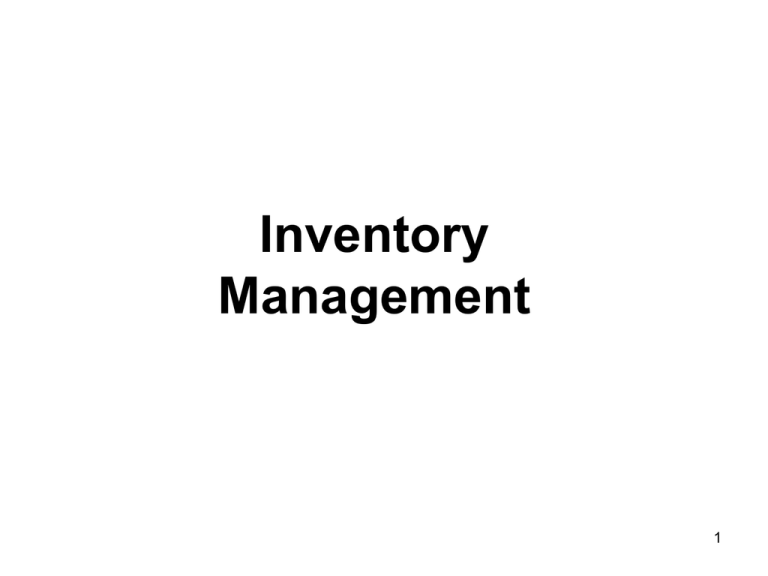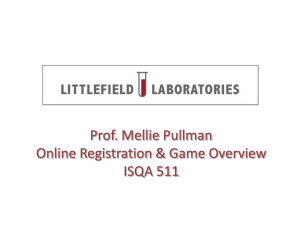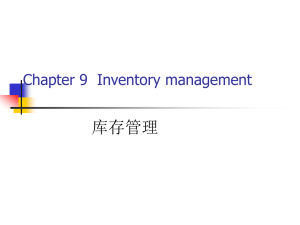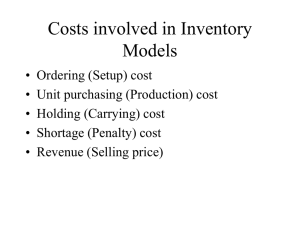ดาวโหลดไฟล์
advertisement

Inventory Management 1 Learning Objectives • • • • Define the term inventory and list the major reasons for holding inventories; and list the main requirements for effective inventory management. Discuss the nature and importance of service inventories Discuss the objectives of inventory management. Describe the A-B-C approach and explain how it is useful. 2 Learning Objectives • • • Describe the basic EOQ model and its assumptions and solve typical problems. Describe the economic production quantity model and solve typical problems. Describe reorder point models and solve typical problems. 3 What is inventory? • Examples: – Parts in a factory – Paper towels in your cupboard – Customers on hold – Paperwork in secretary’s in-box • Not limited to physical products Inventory is DELAY in business process. 12-4 What is inventory? Within organization: Input Raw materials • Materials received • Customers waiting in a bank • Paperwork in inbox Transformation Work-in-Process • Semi-finished products • Customers at the counter • Paperwork on desk Between organizations: Goods-in-transit 12-5 Output Finished goods • Products waiting to be shipped • Customers leaving the bank • Paperwork in outbox Types of Inventories 1. Raw materials & purchased parts 2. Partially completed goods called work in progress (WIP) 3. Finished-goods inventories (manufacturing firms or merchandise, retail stores) 6 Types of Inventories (Cont’d) 4. Replacement parts, tools, & supplies 5. Goods-in-transit to warehouses or customers 7 Functions of Inventory • To meet anticipated demand (anticipation stock) • To maintain continuity of operations (buffer stock) • To protect against stock-outs, i.e. decrease the risk of shortages due to delayed delivery and unexpected increases in demand, (safety stock) • To take advantage of quantity discounts 8 Objective of Inventory Control • To achieve satisfactory levels of customer service while keeping inventory costs within reasonable bounds (limits), there are 2 concerns: 1. Level of customer service • Right goods (in sufficient quantities) • Right place • Right time 2. Costs of ordering and carrying inventory 9 Effective Inventory Management • A system to keep track of inventory • A reliable forecast of demand • Knowledge of lead times • Reasonable estimates of – Holding costs – Ordering costs – Shortage costs • A classification system 10 Inventory Tracking Systems • Periodic System Physical count of items made at periodic intervals • Perpetual Inventory System System that keeps track of removals from inventory continuously, thus monitoring current levels of each item Perpetual = all-time, เป็ นไปอย่างต่อเนื่ อง ตลอดเวลา 11 Inventory Tracking Systems (Cont’d) • Two-Bin System - Two containers of inventory; reorder when the first is empty • Universal Product Code (UPC) - Bar code printed on a label that has 0 information about the item to which it is attached 214800 232087768 12 ABC Classification System Classifying inventory according to some measure of importance and allocating control efforts accordingly. A - very important B - mod. important C - least important High A Annual $ value of items B C Low Low High 13 Percentage of Items ABC Classification System Item # 1 2 3 4 5 6 7 8 9 10 Annual demand Unit cost ($) 2500 360 1000 70 2,400 500 1500 100 700 70 1000 1000 200 210 1000 4000 8000 10 500 200 Annual Dollar Value 14 ABC Classification System Item Annual Dollar value Classification % items % Annual Dollar value 8 4,000,000 A 10 3 1,200,000 B 30 6 1,000,000 B 1 900,000 B 4 150,000 C 10 C 9 C 2 C 5 C 7 C 60 A item is 10 -20% of the number of items but 60-70% of the annual dollar 15 C item is 50-60% of the number of items but 10-15% of the annual dollar Normally, A items should receive close attention (frequent reviews) while C items should receive only loose control. Cycle Counting • A physical count of items in inventory • Cycle counting management – How much accuracy is needed? (± 0.2% for A items, ± 1% B items, and ± 5% C items) – When should cycle counting be performed? – Who should do it? 16 Inventory Models • Independent demand – finished goods, items that are ready to be sold – E.g. a computer • Dependent demand – components of finished products – E.g. parts that make up the computer 17 Inventory Models Independent Demand Items Dependent Demand Items A C(2) B(4) D(2) E(1) D(3) F(2) 18 Economic Order Quantity Models • Economic order quantity (EOQ) model – The order size that minimizes total annual cost • Economic production model • Quantity discount model 19 Assumptions of EOQ Model • Only one product is involved • Annual demand requirements known • Demand is even throughout the year • Lead time does not vary • Each order is received in a single delivery • There are no quantity discounts 20 The Inventory Cycle Profile of Inventory Level Over Time Q Quantity on hand Usage rate Reorder point Receive order Place Receive order order Place Receive order order Time Lead time 21 The Inventory Cycle Large Q Small Q Time 22 Total Cost Annual Annual Total cost = carrying + ordering cost cost TC = Q H 2 + DS Q 23 Cost Minimization Goal Annual Cost The Total-Cost Curve is U-Shaped Q D TC H S 2 Q Ordering Costs QO (optimal order quantity) Order Quantity (Q) 24 Deriving the EOQ Using calculus, we take the derivative of the total cost function and set the derivative (slope) equal to zero and solve for Q. Q OPT = 2DS = H 2(Annual Demand )(Order or Setup Cost ) Annual Holding Cost 25 Minimum Total Cost The total cost curve reaches its minimum where the carrying and ordering costs are equal. Q H 2 = DS Q 26 Economic Production Quantity (EPQ) • Production done in batches or lots • Capacity to produce a part exceeds the part’s usage or demand rate • Assumptions of EPQ are similar to EOQ except orders are received incrementally during production 27 Economic Production Quantity Assumptions • • • • • • • Only one item is involved Annual demand is known Usage rate is constant Usage occurs continually Production rate is constant Lead time does not vary No quantity discounts 28 EPQ: Inventory Profile Q Q* Production and usage Usage only Production and usage Usage only Production and usage Cumulative production Imax Amount on hand Time 29 EPQ – Total Cost T C CarryingCost Set up Cost D I max H S Q 2 where I max Maximuminvent ory Q p u p p P roduct ionor deliveryrat e u Usage rat e 30 Economic Run Size Q0 2DS p H p u 31 Total Costs with Purchasing Cost Annual Annual Purchasing + TC = carrying + ordering cost cost cost Q H TC = 2 + DS Q + PD 32 Cost Total Costs with PD Adding Purchasing cost doesn’t change EOQ TC with PD TC without PD PD 0 EOQ Quantity 33 Total Cost with Constant Carrying Costs Total Cost TCa TCb Decreasing Price TCc CC a,b,c OC EOQ Quantity 34 Quantity Discounts 35 Quantity Discounts 36 When to Reorder • Reorder point – When the quantity on hand of an item drops to this amount, the item is reordered. – Determinants of the reorder point 1. 2. 3. 4. The rate of demand The lead time The extent of demand and/or lead time variability The degree of stockout risk acceptable to management 37 Reorder Point: Under Certainty ROP d LT where d Demand rate (units per period, per day, per week) LT Lead time (in same time units as d ) 38 Reorder Point: Under Uncertainty • Demand or lead time uncertainty creates the possibility that demand will be greater than available supply • To reduce the likelihood of a stockout, it becomes necessary to carry safety stock – Safety stock • Stock that is held in excess of expected demand due to variable demand and/or lead time Expected demand ROP Safety Stock during lead time 39 Quantity Safety Stock Maximum probable demand during lead time Expected demand during lead time ROP Safety stock LT Safety stock reduces risk of stockout during lead time Time 40 12-40 Safety Stock? • As the amount of safety stock carried increases, the risk of stockout decreases. – This improves customer service level • Service level – The probability that demand will not exceed supply during lead time – Service level = 100% - Stockout risk 41 12-41 How Much Safety Stock? • The amount of safety stock that is appropriate for a given situation depends upon: 1. The average demand rate and average lead time 2. Demand and lead time variability 3. The desired service level Expecteddemand ROP z dLT during lead time where z Number of standarddeviations dLT T hestandarddeviationof lead timedemand 42 Distribution of Lead Time Demand 43 Reorder Point The ROP based on a normal Distribution of lead time demand Service level Risk of a stockout Probability of no stockout Expected demand 0 ROP Quantity Safety stock z z-scale 44 Reorder Point: Demand Uncertainty ROP d LT z d LT where z Number of standard deviations d Average demand per period (per day, per week) d The stddev. of demand per period (same time units as d ) LT Lead time (same time units as d ) Note: dLT d LT 45 Reorder Point: Lead Time Uncertainty ROP d LT zd LT where z Number of standard deviations d Demand per period (per day, per week) LT The stddev. of lead time (same time units as d ) LT Average lead time (same time units as d ) Note: dLT d LT 46 Reorder Point: both Demand and Lead Time are uncertain (variable) ROP d LT z dLT where dLT LT d d 2 2 2 LT 47 ROP equations of different cases 48 Fixed-Order-Interval Model • • • • Orders are placed at fixed time intervals Order quantity for next interval? Suppliers might encourage fixed intervals May require only periodic checks of inventory levels • Risk of stockout • Fill rate – the percentage of demand filled by the stock on hand 49 Fixed-Interval Benefits • Tight control of inventory items • Items from same supplier may yield savings in: – Ordering – Packing – Shipping costs • May be practical when inventories cannot be closely monitored 50 Fixed-Interval Disadvantages • Requires a larger safety stock • Increases carrying cost • Costs of periodic reviews 51 Fixed-Quantity vs. Fixed-Interval Ordering 52 When to order How much to order Fixed-quantity (orders are triggered by a quantity) ROP d LT z dLT demand safety stock Fixed-interval (orders are triggered by time) EOP (Economic Order Period) = 2S it is OI DH Fixed-quantity (orders are triggered by a quantity) 2DS EOQ = H Fixed-interval (orders are triggered by time) Amount for order = Expected demand during production interval + SS – Amount on hand at reorder time = d (OI LT ) z d OI LT A excel 53 Exp 1บริ ษทั เครื่ องซักผ้า กรุ งเทพ จากัด ผูป้ ระกอบเครื่ องซักผ้าจาหน่ายทั้งภายในและต่างประเทศ กาลังพิจารณานโยบายการสัง่ ซื้อมอเตอร์รุ่น A1 ที่ใช้ในการประกอบเครื่ องซักผ้าเพื่อให้มีความ ถูกต้องและเชื่อถือได้มากยิง่ ขึ้น โดยกาหนดระดับบริ การ (service Level) ไว้ที่ 95% ผูจ้ ดั การฝ่ ายวัสดุได้รับหมอบหมายจากทางบริ ษทั ให้ทาหน้าที่วเิ คราะห์ปัญหาดังกล่าวนี้ โดยได้ริเริ่ ม รวบรวมข้อมูลจากอดีตที่ผา่ นมาดังนี้ อัตราการใช้ต่อปี = 3000 หน่วย ค่าใช้จ่ายในการสัง่ ซื้อต่อครั้ง = 1000 บาท ต้นทุนในการถือครองของคงคลัง = 35% ต่อปี ต้นทุนมอเตอร์ต่อหน่วย = 1000 บาท (อัตราการใช้ = 55 หน่วย/สัปดาห์) (ค่าเบี่ยงเบนมาตรฐานของอัตราการใช้ = 20.2 หน่วยต่อสัปดาห์) ช่วงเวลานาในการสัง่ ซื้อ 1 สัปดาห์ค่อนข้างคงที่ ข้อมูลอัตราการใช้ค่อนข้างจะมีความแปรปรวนโดยผูจ้ ดั การฝ่ ายวัสดุได้รวบรวมข้อมูลอัตราการใช้ต่อ สัปดาห์ จากอดีตที่ผา่ นมาล่าสุ ด 63 สัปดาห์ ดังแสดงในตารางถัดไปโดยข้อมูลมีการกระจายแบบ ปกติหาขนาดรุ่ นของการสัง่ ซื้อที่ประหยัดสุ ด(EOQ)มต้นทุนรวมการควบคุมของคงคลัง (TC), 54 จุดสัง่ ซื้อใหม่ (ROP) อัตราการใช้ใน 1 สัปดาห์ ความถี่ที่เกิดขึ้นของอัตราการใช้ 10 1 20 2 30 5 40 12 50 15 60 11 70 7 80 4 90 3 100 2 110 1 รวม 63 55 Exp 2 จากตัวอย่างในข้อ 1 ถ้าบริ หารของคงคลังภายใต้ระบบรอบเวลาสัง่ คงที่ โดยใช้ขอ้ มูลเดิมดังนี้ อัตราการใช้ต่อปี = 3000 หน่วย ค่าใช้จ่ายในการสัง่ ซื้อต่อครั้ง = 1000 บาท ต้นทุนในการถือครองของคงคลัง = 35% ต่อปี ต้นทุนมอเตอร์ต่อหน่วย = 1000 บาท อัตราการใช้ = 55 หน่วย/สัปดาห์ ค่าเบี่ยงเบนมาตรฐาน = 20.2 หน่วยต่อสัปดาห์ ช่วงเวลานาในการสัง่ ซื้อ 1 สัปดาห์ค่อนข้างคงที่ กาหนดให้ 1ปี สัปดาห์ หรื อ 365 วัน หมายเหตุ หากในการสัง่ ซื้อมอเตอร์รอบนี้ มีของคงคลังเหลืออยู่ 110 หน่วย 56 บริ ษทั เครื่ องซักผ้ากรุ งเทพ ที่ได้กล่าวถึงในตัวอย่างแล้วต้องการวิเคราะห์ของคงคลังที่มี ความสาคัญอีกรายการหนึ่ ง คือ ใบพัดของเครื่ องซักผ้า ซึ่ งเป็ นชิ้นส่ วนพลาสติกคุณภาพดี โดยกาหนดระดับบริ การไว้ที่ (service level) 98% ขอมูลที่ได้จากการรงบรวมใน อดีตมีดงั ต่อไปนี้ อัตราการใช้ต่อปี = 6000 หน่วย ค่าใช้จ่ายในการสั่งซื้ อต่อครั้ง = 1000 บาท ต้นทุนในการถือครองของคงคลัง = 25% ต่อปี ต้นทุนมอเตอร์ ต่อหน่วย = 400 บาท อัตราการใช้ = 20 หน่วย/วัน (คงที่) ข้อมูลช่วงเวลาในการนาส่ งมอบ (lead time) จากผูส้ ่ งมอบมีความแปรปรวน โดยข้อมูลของ เวลาในการนาส่ งมอบที่ได้จากการแสดงได้จากตารางดังนี้ 57 ช่วงเวลานา (วัน) ความถี่ที่เกิดขึ้นของช่วงเวลา นา 10 11 12 13 14 15 16 17 รวม 1 6 7 22 9 3 1 1 50 58









